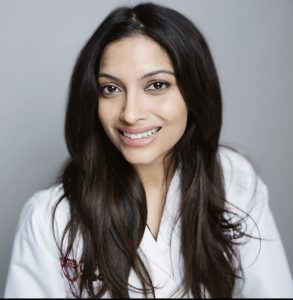As an interventional radiologist who teaches and performs clinical work, Divya Kumari, MD, keenly understands her role as an ABR volunteer who writes Qualifying (Core) Exam questions.
It’s a balancing act.
“I have a good idea of what (candidates) should know, particularly diagnostic residents,” she said. “We’re writing questions that they have to be able to answer. Often when I’m working, I’m also paying attention to the scope of what they understand to make sure what we’re writing isn’t too difficult and it’s not intended toward fellowship level for IR.”
Dr. Kumari, an assistant professor of radiology at UChicago Medicine, is in her second year of writing questions for the Core. She earned her medical degree from St. George’s University School of Medicine, performed her residency at Case Western Reserve College of Medicine and completed a vascular and interventional radiology fellowship at the University of Chicago Medical Center.

She works with residents and fellows all day, none of whom know that she’s an ABR volunteer.
“I’m teaching all the time … truly, 100 percent,” she said.
Dr. Kumari estimates that she dedicates as much as 15% of her workload to diagnostic radiology. She enjoys the procedural side of interventional radiology, but said she’ll never let go of her love of imaging.
“It’s important for me to maintain my diagnostic skills. I genuinely enjoy that aspect of radiology,” she said. “There’s a unique sense of fulfillment in identifying a critical finding on a patient in the ER or ICU and being able to immediately call the physician with an answer. That can be just as rewarding as performing a procedure. I strive to keep a balance between both diagnostic and interventional work.”
She’s also contributing as an ABR volunteer. As is the case with everyone who creates exam content, Dr. Kumari went through a breaking-in period before she felt comfortable.
The puzzle pieces came together when her committee met in Chicago to assemble the exam. Going through the final round of question vetting and discussing potential issues with fellow subject matter experts enabled her to fully understand the process.
“Sitting down for two days straight and going through all the questions, and all the different ways of asking the same topic, really nailed it down,” Dr. Kumari said. “I felt a lot more comfortable after that.”
Two long days of question reviewing and other work to finalize the exam is challenging. Dr. Kumari likened the experience to when she took initial certification exams as a candidate.
It reminded me of what it was like to be on the other side, taking those long exams,” she said. “It’s definitely a marathon, but a much more enjoyable one. I really appreciated getting to meet the other volunteers in person. Our team had a great time overall. It’s a fun group, and I genuinely enjoyed the whole process
Brian Funaki, MD, encouraged Dr. Kumari to volunteer for the ABR. Dr. Funaki has written exam questions and served as an oral examiner.
“She is a young, bright interventional radiologist who has a strong interest in education and teaching,” he said. “In a male-dominated field, we need more talented women like her to serve as mentors and role models for the next generation of interventional radiologists.”
As a question writer, Dr. Kumari has seen a few myths shattered. When she was a candidate, she worried that questions were included to intentionally mislead examinees. After sitting through extensive reviews with her group, she has seen questions tossed because volunteers didn’t find them suitable.
“Knowing the questions weren’t designed to trick you would’ve made me a lot less anxious going into the exam,” she said.
Volunteer duties are never far from her mind. She finds that working at a hospital that serves a diverse population provides real-world scenarios that are appropriate for examinees.
“We did a case this morning, and as soon as I saw the images, I thought, ‘This would make a great board question,’” she said. “I really appreciate the wide spectrum of cases we see here. It gives me a lot of material to work with.”
Spending time with colleagues away from meeting rooms is a nice bonus for volunteers. Discussing their professional and personal lives during breaks builds connections and camaraderie, enabling the team to work well together.
“We have lunches and dinners where we really get to know each other and understand each other’s perspectives,” she said. “That’s been one of the most rewarding parts of volunteering with the ABR.”


